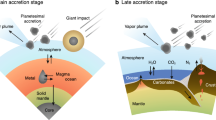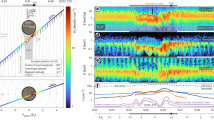Abstract
For decades, the source of Earth's volatiles, especially water with a deuterium-to-hydrogen ratio (D/H) of (1.558 ± 0.001) × 10−4, has been a subject of debate. The similarity of Earth’s bulk composition to that of meteorites known as enstatite chondrites1 suggests a dry proto-Earth2 with subsequent delivery of volatiles3 by local accretion4 or impacts of asteroids or comets5,6. Previous measurements in six comets from the Oort cloud yielded a mean D/H ratio of (2.96 ± 0.25) × 10−4. The D/H value in carbonaceous chondrites, (1.4 ± 0.1) × 10−4, together with dynamical simulations, led to models in which asteroids were the main source of Earth's water7, with ≤10 per cent being delivered by comets. Here we report that the D/H ratio in the Jupiter-family comet 103P/Hartley 2, which originated in the Kuiper belt, is (1.61 ± 0.24) × 10−4. This result substantially expands the reservoir of Earth ocean-like water to include some comets, and is consistent with the emerging picture of a complex dynamical evolution of the early Solar System8,9.
This is a preview of subscription content, access via your institution
Access options
Subscribe to this journal
Receive 51 print issues and online access
$199.00 per year
only $3.90 per issue
Buy this article
- Purchase on Springer Link
- Instant access to full article PDF
Prices may be subject to local taxes which are calculated during checkout


Similar content being viewed by others
References
Javoy, M. et al. The chemical composition of the Earth: enstatite chondrite models. Earth Planet. Sci. Lett. 293, 259–268 (2010)
Wänke, H. Constitution of terrestrial planets. Phil. Trans. R. Roc. Lond. 303, 287–302 (1981)
Robert, F. A distinct source of lunar water? Nature Geosci. 4, 74–75 (2011)
Drake, M. J. & Righter, K. Determining the composition of the Earth. Nature 416, 39–44 (2002)
Oró, J. Comets and the formation of biochemical compounds on the primitive Earth. Nature 190, 389–390 (1961)
Owen, T., Bar-Nun, A. & Kleinfeld, I. Possible cometary origin of heavy noble gases in the atmospheres of Venus, Earth and Mars. Nature 358, 43–46 (1992)
Morbidelli, A. et al. Source regions and time scales for the delivery of water to Earth. Meteorit. Planet. Sci. 35, 1309–1320 (2000)
Tsiganis, K., Gomes, R., Morbidelli, A. & Levison, H. F. Origin of the orbital architecture of the giant planets of the Solar System. Nature 435, 459–461 (2005)
Gomes, R., Levison, H. F., Tsiganis, K. & Morbidelli, A. Origin of the cataclysmic Late Heavy Bombardment period of the terrestrial planets. Nature 435, 466–469 (2005)
Levison, H. F. & Duncan, M. J. From the Kuiper belt to Jupiter-family comets: the spatial distribution of ecliptic comets. Icarus 127, 13–32 (1997)
Dones, L., Weissman, P. R., Levison, H. F. & Duncan, M. J. in Comets II (eds Festou, M. C., Keller, H. U. & Weaver, H. A. ) 153–174 (Univ. Arizona Press, 2005)
Hartogh, P. et al. Water and related chemistry in the solar system: a guaranteed time key programme for Herschel. Planet. Space Sci. 57, 1596–1606 (2009)
Meech, K. et al. EPOXI: 103P/Hartley 2 observations from a worldwide campaign. Astrophys. J. 734, L1 (2011)
Biver, N. et al. Submillimetre observations of comets with Odin: 2001–2005. Planet. Space Sci. 55, 1058–1068 (2007)
Linsky, J. L. et al. What is the total deuterium abundance in the local galactic disk? Astrophys. J. 647, 1106–1124 (2006)
Butner, H. M. et al. Discovery of interstellar heavy water. Astrophys. J. 659, L137–L140 (2007)
Watson, W. D. Ion-molecule reactions, molecule formation, and hydrogen-isotope exchange in dense interstellar clouds. Astrophys. J. 188, 35–42 (1974)
Geiss, J. & Reeves, H. Cosmic and solar system abundances of deuterium and helium-3. Astron. Astrophys. 18, 126–132 (1972)
Drouart, A., Dubrulle, B., Gautier, D. & Robert, F. Structure and transport in the solar nebula from constraints on deuterium enrichment and giant plant formation. Icarus 140, 129–155 (1999)
Mousis, O. et al. Constraints on the formation of comets from D/H ratios measured in H2O and HCN. Icarus 148, 513–525 (2000)
Aikawa, Y. & Herbst, E. Two-dimensional distributions and column densities of gaseous models in protoplanetary disks II. Deuterated species and UV shielding by ambient clouds. Astron. Astrophys. 371, 1107–1117 (2001)
Emel’yanenko, V. V., Asher, D. J. & Bailey, M. E. Centaurs from the Oort cloud and the origin of Jupiter-family comets. Mon. Not. R. Astron. Soc. 361, 1345–1351 (2005)
Marzari, F., Farinella, P. & Vanzani, V. Are Trojan collisional families a source for short-period comets? Astron. Astrophys. 299, 267–276 (1995)
Thi, W.-F., Woitke, P. & Kamp, I. Warm non-equilibrium gas phase chemistry as a possible origin of high HDO/H2O ratios in hot and dense gases: application to inner protoplanetary discs. Mon. Not. R. Astron. Soc. 407, 232–246 (2010)
Walsh, K. J. & Morbidelli, A. The effect of an early planetesimal-driven migration of the giant planets on terrestrial planet formation. Astron. Astrophys. 526, A126 (2011)
Delsemme, A. H. The deuterium enrichment observed in recent comets is consistent with the cometary origin of seawater. Planet. Space Sci. 47, 125–131 (1998)
Greenwood, J. P. et al. Hydrogen isotope ratios in lunar rocks indicate delivery of cometary water to the Moon. Nature Geosci. 4, 79–82 (2011)
Jørgensen, U. G. et al. The Earth-Moon system during the late heavy bombardment period — geochemical support for impacts dominated by comets. Icarus 204, 368–380 (2009)
Zakharov, V., Bockelée-Morvan, D., Biver, N., Crovisier, J. & Lecacheux, A. Radiative transfer simulation of water rotational excitation in comets. Comparison of the Monte Carlo and escape probability methods. Astron. Astrophys. 473, 303–310 (2007)
Bensch, F. & Bergin, E. A. The pure rotational line emission of ortho-water in comets. I. Radiative transfer model. Astrophys. J. 615, 531–544 (2004)
Acknowledgements
Herschel is an ESA space observatory with science instruments provided by European-led Principal Investigator consortia and with important participation by NASA. The Heterodyne Instrument for the Far Infrared (HIFI) has been designed and built by a consortium of institutes and university departments from across Europe, Canada and the United States under the leadership of SRON, the Netherlands Institute for Space Research, and with major contributions from Germany, France and the USA. This development has been supported by national funding agencies: CEA, CNES, CNRS (France); ASI (Italy); and DLR (Germany). Additional funding support for some instrument activities has been provided by ESA. Support for this work was also provided by NASA through an award issued by JPL/Caltech. D.C.L. is supported by an NSF award to the Caltech Submillimeter Observatory. We thank R. Lorente, P. García-Lario, M. Kidger and G. Pilbratt for helping with the scheduling of these observations, and I. Avruch for the assistance with HIFI specific software issues.
Author information
Authors and Affiliations
Contributions
This paper represents the combined work of the HssO (the Herschel guaranteed time key programme “Water and related chemistry in the solar system”) team members listed as authors. P.H. is the coordinator of this programme. All authors contributed to this work, including observation planning, data analysis and writing of the manuscript. N.B., D.B.-M., M.R., R.M, M.d.V.-B. and M.E. carried out the data reduction and contributed to the modelling efforts. All authors were collectively involved in the discussion and interpretation of the results.
Corresponding author
Ethics declarations
Competing interests
The authors declare no competing financial interests.
Supplementary information
Supplementary Information
The file contains Supplementary Text, Supplementary References and Supplementary Table 1. (PDF 214 kb)
PowerPoint slides
Rights and permissions
About this article
Cite this article
Hartogh, P., Lis, D., Bockelée-Morvan, D. et al. Ocean-like water in the Jupiter-family comet 103P/Hartley 2. Nature 478, 218–220 (2011). https://doi.org/10.1038/nature10519
Received:
Accepted:
Published:
Issue Date:
DOI: https://doi.org/10.1038/nature10519
This article is cited by
-
The Comet Interceptor Mission
Space Science Reviews (2024)
-
A solar wind-derived water reservoir on the Moon hosted by impact glass beads
Nature Geoscience (2023)
-
Deuterium-enriched water ties planet-forming disks to comets and protostars
Nature (2023)
-
Cometary science with CUBES
Experimental Astronomy (2023)
-
PAHs, hydrocarbons, and dimethylsulfides in Asteroid Ryugu samples A0106 and C0107 and the Orgueil (CI1) meteorite
Earth, Planets and Space (2023)
Comments
By submitting a comment you agree to abide by our Terms and Community Guidelines. If you find something abusive or that does not comply with our terms or guidelines please flag it as inappropriate.



